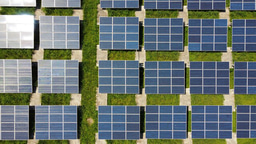Transforming Energy Efficiency: Power-Generating Semi-Transparent Windows
Published in Chemistry, Materials, and Civil Engineering

In our journey toward sustainability, the role of buildings is often overlooked, despite accounting for 40% of global energy consumption. Surprisingly, windows alone are responsible for 40% of energy losses in buildings, leading to a massive drain of resources and adding to carbon emissions. Our research aims to address this gap with an innovative approach: a thermoelectric glazing system that both minimizes heat loss and generates electricity by harnessing temperature differences between indoor and outdoor environments.
Rethinking the Window: Power Generation Meets Energy Efficiency
Our project began with a simple question: how can we turn windows from energy liabilities into assets? The answer lies in an advanced, semi-transparent glazing design built from thermoelectric materials that effectively capture temperature differences and convert them into electricity. This breakthrough capitalizes on the thermoelectric effect, where a temperature difference across a material can generate electric voltage, creating a steady power source for the building.
Innovations in Design, Materials, and Accessibility
The success of our glazing system hinges on several innovations. First, the materials we chose are not only abundant and low-cost but also have superior thermal properties, making them ideal for energy conversion. Additionally, our fabrication process is straightforward and economical, enabling large-scale production. Unlike many renewable energy technologies, this glazing is semi-transparent, preserving windows' natural light—a crucial factor for architectural compatibility. In the face of urgent climate change concerns and the pressing need to lower carbon emissions, thermoelectric (TE) energy has gained attention as a promising sustainable technology. Our recent research highlights a semi-transparent thermoelectric glazing system (TEGZ) engineered with affordability and scalability in mind. Crafted using two optimized TE materials—n-type aluminium-doped zinc oxide (AZO) and p-type copper iodide (CuI)—this system exemplifies the potential for eco-friendly energy solutions in modern building design.
Key Findings and Innovations in Thermoelectric Material Efficiency
The success of our glazing system hinges on several innovations. First, the materials we chose are abundant and low-cost and have superior thermal properties, making them ideal for energy conversion. Additionally, our fabrication process is straightforward and economical, enabling large-scale production. Unlike many renewable energy technologies, this glazing is semi-transparent, preserving windows' natural light—a crucial factor for architectural compatibility.
Through meticulous material selection and optimization, we achieved impressive efficiency metrics. AZO, chosen for its low thermal conductivity (k) and high power factor (PF), attained a thermoelectric figure of merit (ZT) of 1.37 at 340 K. This efficiency boost is linked to reductions in particle size and enhanced material crystallization. Meanwhile, CuI reached a ZT of 0.72 at 340 K, showing promise due to its low thermal conductivity, high electrical conductivity (σ), and heightened Seebeck coefficient, likely due to copper vacancies acting as point defects.
The choice of fluorine-doped tin oxide (FTO) glass as a substrate also significantly influenced the TE properties of these materials, enhancing both conductivity and transparency. Optimizing transparency was essential for TEGZ’s application in Windows, with AZO achieving 76% transparency at an 800 nm thickness and CuI 64% at a 2.7 µm thickness—levels suitable for semi-transparent architectural applications.
Performance and Dual Functionality of the TEGZ System
When installed in windows, this thermoelectric glazing could halve heat loss, allowing buildings to retain more warmth in winter and stay cooler in summer. The generated energy can be stored or used immediately, reducing dependence on external power and shrinking the building's carbon footprint. The system requires no additional heating or cooling mechanisms, making it a clean and self-sustaining solution. The TEGZ nanogenerator produced an output of 32 nW at 340 K with a 30 K temperature gradient, demonstrating its capability to generate useful power in response to temperature differences. Beyond energy generation, the system’s ability to maintain a 22.5 °C temperature difference between exterior and interior surfaces highlights its dual role: effective thermoelectric conversion and substantial heat loss reduction.
Implications for the Future of Building Efficiency
This research paves the way for a future where thermoelectric glazing could become a standard in urban buildings, contributing significantly to energy efficiency and sustainability goals. With further development, thermoelectric windows may become a fixture in green buildings worldwide, helping us work toward net-zero carbon emissions. Modifying the intrinsic properties of existing materials represents a crucial pathway for advancing sustainable technologies. The TEGZ system exemplifies how combining cost-effective materials with optimized fabrication methods can yield scalable, energy-efficient solutions for modern architecture. By integrating these thermoelectric glazing systems into building designs, we take a meaningful step toward reducing carbon footprints and achieving more sustainable, energy-independent buildings in a warming world.
Follow the Topic
-
Communications Engineering

A selective open access journal from Nature Portfolio publishing high-quality research, reviews and commentary in all areas of engineering.
Related Collections
With Collections, you can get published faster and increase your visibility.
Applications of magnetic particles in biomedical imaging, diagnostics and therapies
Publishing Model: Open Access
Deadline: Dec 31, 2025
Integrated Photonics for High-Speed Wireless Communication
Publishing Model: Open Access
Deadline: Dec 31, 2025






Please sign in or register for FREE
If you are a registered user on Research Communities by Springer Nature, please sign in